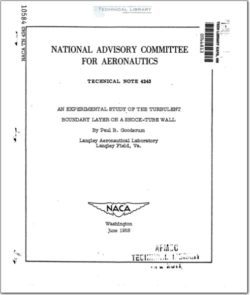NACA-TN-4243

- Version
- 120 Downloads
- 1.91 MB File Size
- 1 File Count
- December 4, 2015 Create Date
- December 4, 2015 Last Updated
National Advisory Committee for Aeronautics, Technical Notes - An Experimental Study of the Turbulent Boundary Layer on a Shock Tube Wall

Interferometric measurements were made of the density profiles of
an unsteady turbulent boundary layer on the flat wall of a shock tube.
The investigation included.both subsonic and supersonic flow (Mach nump
bers of 0.50 and 1.77) with no pressure gradient and with heat transfer
to a cold wall. Velocity profiles and average skin—friction coefficients
were calculated. Effects on the velocity profile of surface roughness
and flow length are examined.
In the application of the shock tube as a high-temperature test
facility, a knowledge of the physical characteristics of the time-
dependent boundary layer on the shock—tube wall is desirable since skin—
friction and heat—conduction effects can be such as to alter the resulting
flow from that predicted by ideal—flow theory. The theoretical methods
by which these effects can be calculated for a turbulent boundary layer
involve the assumption of a specific velocity profile, and there is very
little experimental data in the literature upon which to base this assump-
tion. Recently, subsonic velocity profiles of shock-induced flow on
rough surfaces have been measured by means of a bullet technique (ref. 1).
Mach-Zehnder interferometer studies of the boundary—layer growth on shock-
tube walls have been reported in references 2 and 3 for shock~tube flows
with low subsonic and supersonic free-stream velocities, respectively,
but no attempts were made therein to calculate the velocity or other per-
tinent parameters from the measured density distributions. An interfer—
ometric investigation of boundary-layer velocity profiles in shock-tube
flow was conducted at both subsonic and supersonic free-stream velocities
in reference A, but was restricted to the study of the laminar portion
of the flow.
The purpose of the present investigation was, therefore, the inter-
ferometric study of the turbulent—boundary-layer characteristics in both
a subsonic (M = 0.50) and a supersonic (M = 1.77) shock-induced flow. The
shock-tube flow under consideration was essentially an unsteady flow
over a smooth flat plate with no pressure gradient and with heat trans-
fer from the fluid to a cold wall. Also included were the effects of an
evenly distributed, fine roughness.
| File | Action |
|---|---|
| naca-tn-4243.pdf | Download |

Comment On This Post